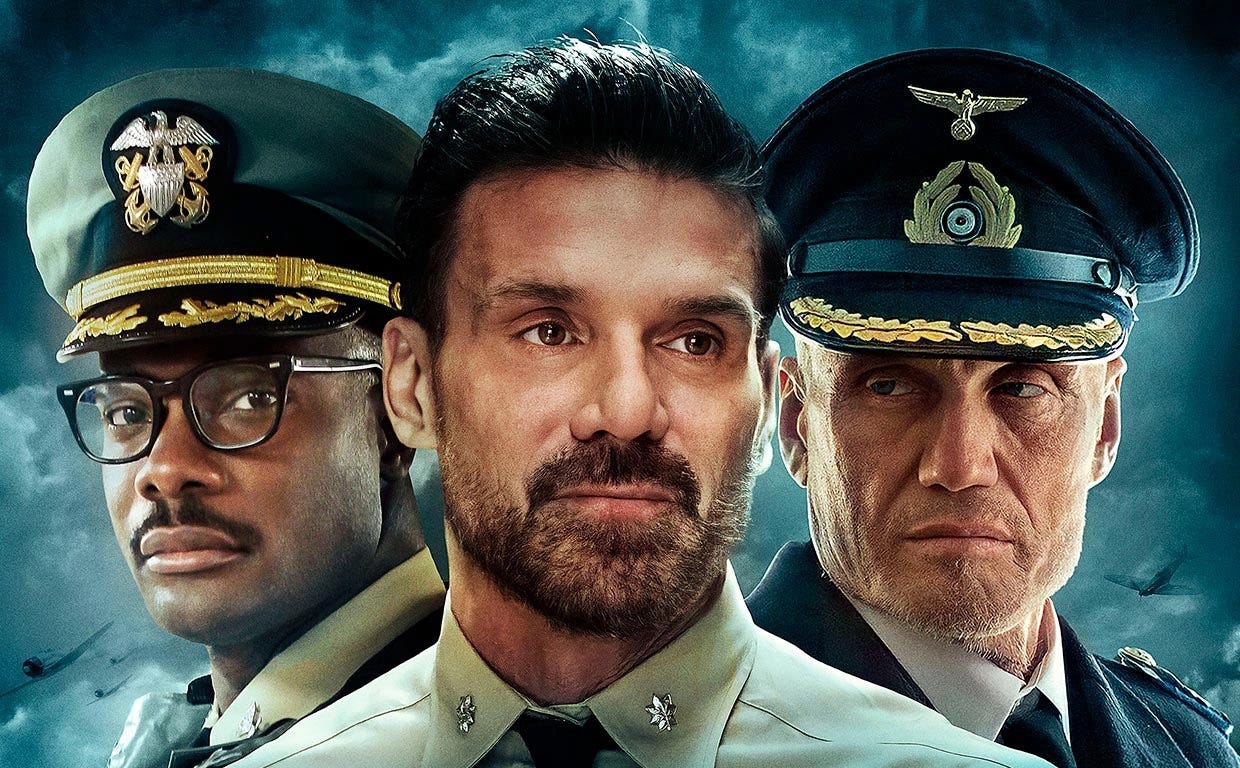Operation Seawolf
A surprisingly strong Dolph Lundgren performance elevates this slight story of military might.
Film Yap is a reader-supported publication. To receive new posts and support my work please consider becoming a free or paid subscriber.
If you’ve followed my efforts on the Film Yap to any degree, you’ve likely noticed that there are a handful of action movie actors whose work I’ll almost always cover. Names such as Scott Adkins, Frank Grillo, Dolph Lundgren and Michael Jai White certainly fit the bill. If two or more of them are in the same flick, all the better – see my recent review of the Adkins/Lundgren joint "Section 8" as evidence. This brings us to the World War II actioneer “Operation Seawolf” (available in select theaters and on VOD beginning Friday, Oct. 7), which features both Grillo and Lundgren.
It’s the last days of WWII. Germany, desperate for one last grasp at victory over the Allies, sends a U-boat captained by the grizzled Hans Kessler (Lundgren) to attack New York. We flash between Kessler’s submarine where he’s clashing for power against Lt. Erich Reinhart (Andrew Stecker), sub chaser USS PC-1264 docked in New York Harbor and led by Capt. Samuel L. Gravely Jr. (Hiram A. Murray) and United States Navy Atlantic Fleet Command in Norfolk, Va. overseen by Cmdr. Race Ingram (Grillo).
From a story perspective, “Seawolf” is a very simple, 86-minute case of will they or won’t they. Will the Germans successfully fire a rocket at New York or will Gravely and Ingram be able to stop them beforehand? That’s it.
Where “Seawolf” becomes interesting is in its portrayal of Kessler. Lundgren is legitimately great in the role. This guy is no Good German. He ain’t heiling no Hitler. He served in the Great War and served his country once more in WWII. He is a husband and father who lost his wife and children in a firebombing. Kessler was chosen for this particular mission because he’s a man with nothing to lose. Hell, the guy opens the picture Martin Riggs-style all hungover and putting a pistol to his head. Lundgren plays not only Kessler’s grief, but a loyalty to his boat and his men beautifully. He makes the unsympathetic sympathetic.
I wish Gravely (who was a real figure and the first African American to serve aboard a fighting ship as an officer) and Ingram were developed better. Murray does a fine job playing Gravely, but we know next to nothing about the character besides the fact that he promises one of his sailors that he’ll get him home safely to his mother.
(All of Gravely’s men are shown as being black, which is true to history as the ships were largely segregated. I suppose it’s good that writer/producer/director Steven Luke is showing as opposed to telling, but there’s a wealth of material here that wasn’t mined. Gravely went on to command a Navy ship and later became a fleet commander, flag officer and vice admiral. I’d like to see a movie all about Gravely and his career, but that isn’t the film Luke opted to make.)
Grillo is OK as Ingram, but I prefer to see him as a man of action as opposed to a man behind a desk, which is where he spends the entirety of his screen time. Grillo is an actor who played his role as written – you can’t ask much more of him than that.
Luke has established a mini-cottage industry making WWI and WWII movies often featuring the likes of Tom Berenger, Billy Zane, Murray, Cody Fleury and often even Luke himself. (Actors Apostolos Gliarmis and Stecker served as first assistant director and second assistant director on the picture respectively.) This is a low-budget affair, but its effects and depictions of military might are convincing enough. There ain’t a lot of meat on these bones (other than Lundgren’s performance), but it’s all captured capably.
Luke already has another WWII movie entitled “Come Out Fighting” slated to come out in 2022. It stars Lundgren, White, Murray and Stecker. You can likely look for my review when this one drops as well since it features two out of four actors from my direct-to-video Mount Rushmore.





